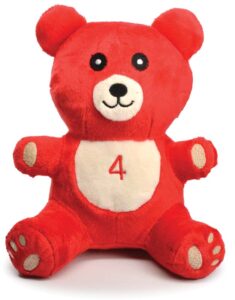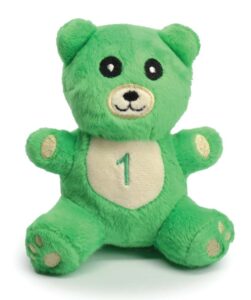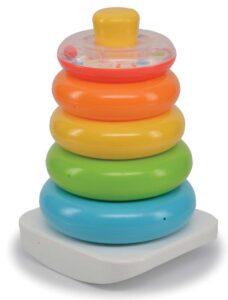Object inquiry skills
An infant participates with a caregiver in open-ended play with two similar toys of different sizes.



Be Prepared: This activity is for an infant who can sit independently or with support. Secure two similar soft toys that clearly differ in size. The activity plan uses a large bear and a small bear.

 Invite an infant to sit next to you on the floor. Hold the larger soft toy where the infant can see it. Speak clearly as you describe the toy and point to features you describe. Example: “This is a big bear. Here are the bear’s eyes. Here is the bear’s nose.”
Invite an infant to sit next to you on the floor. Hold the larger soft toy where the infant can see it. Speak clearly as you describe the toy and point to features you describe. Example: “This is a big bear. Here are the bear’s eyes. Here is the bear’s nose.”
Encourage the infant to touch or hold the toy. Wait and observe the infant’s reaction to the toy. Describe his/her actions. The infant may hug or pat the bear, put part of the bear to his/her mouth, and/or shake the toy.
Next, show the infant the smaller bear. Explain: “This is a small bear.” Describe and point to the small bear’s characteristics. Example: “Here are the small bear’s eyes. Here is the small bear’s nose.” Hold the small bear within the infant’s reach. If the infant is still holding the big bear, he/she may drop the big bear to hold the small bear or attempt to hold both bears.
Support the infant’s play with one or both toys. Generally, infants are interested in pretend actions that represent familiar routines, such as feeding or sleeping. Engage in parallel play with a bear or serve as a helpmate for the infant’s play with one or both bears. There will be an opportunity for you to hold a bear if the infant drops the big bear or hands a bear to you. Use the bear to participate in the play. Example: If the infant hands a bear to you, ask “Do you want me to play with the bear?” and wait for a nonverbal response, such as a look.
Describe the infant’s actions with the toy(s). Also describe your actions. Example: “I am holding the small bear. I give her food. Yum, yum. The small bear likes this food.” Describe characteristics of a toy that the infant is touching or looking at. Example: “Denari, you are touching the bear’s nose. Now you are putting the bear’s nose next to your nose!”
As part of the infant’s play, point out differences between the two bears when appropriate. Examples: “You have the small bear. I have the big bear.” “Do you want to play with the big bear now?” Use gestures to help communicate your meaning.
You might conclude your participation in the play by indicating it is time for your bear to go to sleep. Example: “Small bear is tired. Night night bear.” Lay the bear on the floor and pat it with your hand.
This activity extends prior curriculum support for helping infants notice differences between objects, such as the Block 21 activity in which an infant is offered a choice between two toys. In the current activity, look for ways to point out differences between the two toys without turning the play into a teaching situation. Example: As part of the infant’s interactions with the toys, there may be an opportunity to hold the two bears side by side to emphasize their differences in size. But avoid imposing this comparison on the infant’s interests and actions.
More generally, watch for ways to support the infant’s interests in the toy(s). Focus your attention on actions or toy characteristics that occupy the infant’s attention. You may find a way to incorporate play with the bears into the infant’s other interests. Example: If the infant crawls to a mirror, bring the toy bears to the mirror and playfully reintroduce the bears. If the infant ignores the toy bears, simply put the bears aside and focus on what the infant wants to do.
Extra support
Enrichment
Object inquiry skills
An older infant engages in guided play with different sizes of stacking rings.



 Invite an infant to join you on the floor to play with stacking rings. Sit facing the infant and place the assembled stacking rings toy in front of the infant. Point to and name the rings, including the size differences. Example: “This is a ring. We have many rings. Some rings are big. Some rings are small.” With hand gestures and a supportive facial expression, encourage the infant to remove the rings from the post. Emphasize that the infant is taking the rings off of the post.
Invite an infant to join you on the floor to play with stacking rings. Sit facing the infant and place the assembled stacking rings toy in front of the infant. Point to and name the rings, including the size differences. Example: “This is a ring. We have many rings. Some rings are big. Some rings are small.” With hand gestures and a supportive facial expression, encourage the infant to remove the rings from the post. Emphasize that the infant is taking the rings off of the post.
Provide a minute or two for the infant to manipulate the rings, if interested. Then explain that you will line up the rings. Arrange the rings in a line with the largest ring on the infant’s left side. The smallest ring will be the last in the line, on the far right. Describe what you are doing. After the rings are in a line, point to the largest ring and explain it is a big ring. Point to the smallest ring and explain it is a small ring.
Point to the largest ring and invite the infant to put it back on the post. Pause for the infant to respond. If the infant seems unclear about what to do, carefully put the largest ring on the post. Then remove it from the post so the infant can place the largest ring on the post. Emphasize that the infant is putting a ring on the post.
Encourage the infant to continue putting rings on the post, using the order in which they are placed on the floor. Offer guidance, if appropriate, by simply pointing to which ring goes on next. Emphasize again that the infant is putting rings on the post.
It is not necessary for the infant to place all rings on the post. Enthusiastically acknowledge the infant’s efforts. Example: “Hurray for you, Max! You took all the rings off, and you put the big ring back on the post!”
The activity provides a focused approach to supporting an infant’s awareness of differences in the size of objects. Although a stacking rings toy is familiar to most infants, specific size differences are not obvious to many infants. The activity is more challenging than prior ELM activities on this topic, and should be offered to an older infant. In addition to intended cognitive benefits, the activity supports the fine motor skills involved in manipulating the rings.
Because we read and write in English from the left side to the right, it is helpful for the infant to see objects arranged by size lined up in the same fashion. The activity is not intended to focus on specific differences in ring sizes. The visual display, from largest to smallest, is sufficient at this age. As infants become more familiar with the rings, their attention to size differences will increase.
Some infants may welcome your help in identifying the order of rings to be put on the post. You could take turns with the infant in putting a ring on the post. Other infants may be fine with your arrangement of rings by size on the floor and proceed in their own way. You may wish to simply observe. The common stacking rings toy has a post that is wider at the bottom. The rings will only fit onto the post in the correct order. This provides a self-correcting element for a child. There are stacking ring toys with a uniform-sized rod, allowing a child to stack rings out of order. This type of post supports mostly a fine motor skill, with minimal attention to size.
Extra support
Enrichment
Materials Needed: small toys, unbreakable jar, texture mat, pairs of toys made of different materials, open ball, cloth squares—such as a washcloth, silk fabric, denim, or corduroy
Place a few small toys inside an unbreakable jar. Infants who crawl will be pleased to find a toy inside a container and get it out. Place a texture mat on the floor and arrange no more than three infant toys for exploration.
In different areas of the room, arrange play materials that are similar but different in some important way, such as two balls of different sizes or animal figures made of different materials. Collect several cloth squares with different textures, such as a washcloth, a square of a light, silky fabric, and a square of denim or corduroy. Push the fabric into an open ball and encourage infants to feel the variety of soft textures. Some infants will be interested in removing the fabric. On another day, place several items of different shapes and textures into a basket for crawling and walking infants to explore.
Materials Needed: rattles, soft and hard objects, basket, animal and people figures, pairs of matching items
You may find time to present a rattle to an infant who is seated in a high chair before or after a meal or snack. Toddlers will enjoy exploring a variety of soft and hard objects in a basket. Provide soft and rigid animal and people figures. Talk with toddlers about similarities and differences. Preschool-age children may enjoy reaching into a bag and finding two matching objects using the sense of touch only. Items for the bag could include two small animal figures, two small blocks, two spoons, and/or two small socks.